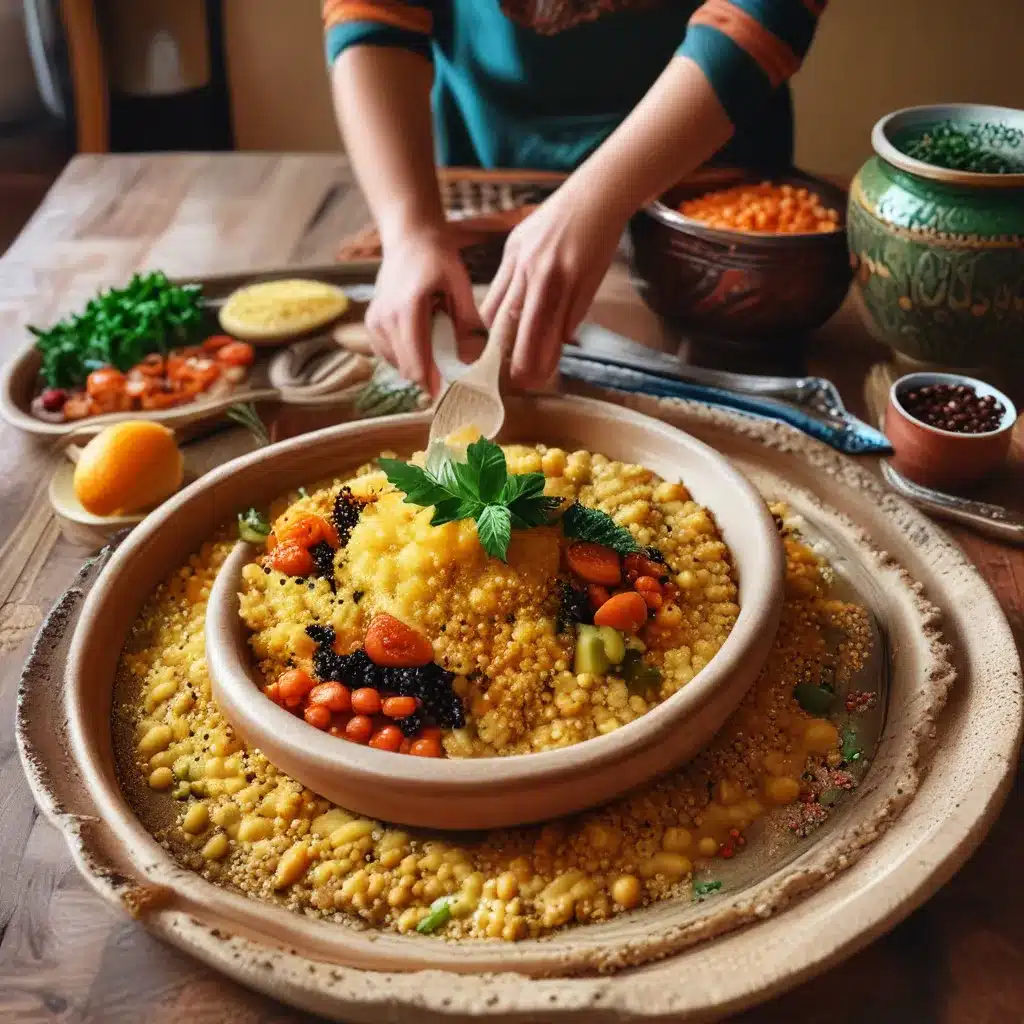
Treasuring Grandma’s Couscous Secrets
As I step into the kitchen, the aroma of simmering spices and tender vegetables instantly transports me back to my childhood in Morocco. The scent of this iconic dish, Moroccan couscous, has been etched into my memory, a culinary legacy passed down through generations. Growing up, I would watch in awe as my grandmother, the undisputed master of this art, meticulously prepared the fluffy grains and harmonized the flavors with unparalleled precision.
Losing my beloved father last year meant bidding farewell to those precious moments of learning and sharing. But, thanks to my brother Ahmed, I’ve been able to preserve the essence of my family’s couscous recipe, bringing the flavors of home to my kitchen in New York City. As I prepare this dish, I can almost hear my father’s voice guiding me, his infectious passion for cooking shining through every step.
Mastering the Couscous Craft
Couscous, the staple grain of Moroccan cuisine, is more than just a side dish – it’s a symbol of family, tradition, and the art of slow-cooked perfection. Unlike the quick-cooking variety found in grocery stores, authentic Moroccan couscous requires a delicate touch and a special piece of equipment known as a couscoussier.
This two-tiered pot is designed to steam the couscous to fluffy, light perfection while the meat and vegetables simmer in the aromatic broth below. It’s a technique that has been honed over centuries, passed down through generations of Moroccan cooks. While the couscoussier is the traditional tool, my brother Ahmed has shared a brilliant shortcut that allows you to achieve the same results using a few good-quality pots.
Crafting the Couscous Masterpiece
To begin, I start by soaking the couscous in warm water, gently massaging the grains to ensure even hydration. This crucial step helps the couscous develop its signature light and airy texture. Once the couscous has had a chance to drink up the moisture, I transfer it to a steamer basket, where it will be gently steamed over the simmering broth.
As the couscous cooks, I turn my attention to the heartbeat of the dish: the fragrant broth. Here, I combine a blend of spices, including cumin, coriander, and the coveted saffron threads. The saffron, with its earthy and slightly floral notes, lends an unmistakable richness to the broth, elevating the entire dish to new heights of flavor.
Next, I add the star of the show – the tender lamb, which has been carefully browned to lock in its succulent juices. Vegetables like carrots, zucchini, and chickpeas join the party, each contributing their own unique character to the stew. As the ingredients mingle and the aromas fill the air, I can almost hear the laughter and chatter of my family, gathered around the table, eagerly awaiting the main event.
Embracing the Communal Experience
In Morocco, the serving of couscous is a ritual, a gathering of loved ones to share in the joy of this beloved dish. Unlike many Moroccan dishes, where hands are the utensil of choice, couscous is traditionally enjoyed with a spoon, allowing everyone to savor the broth and tender morsels.
I can still picture my grandmother, with her nimble fingers, deftly shaping the couscous into small, bite-sized balls, which she would then carefully place in her mouth. This technique, which my father had mastered, always seemed to unlock an extra layer of flavor, a testament to the care and attention poured into every step of the process.
As I serve the couscous, I can’t help but feel a sense of nostalgia. I imagine my family in Morocco, sitting around the table, sharing stories and breaking bread together. It’s a tradition that transcends time and distance, a cultural tapestry that I’m honored to be a part of.
Variations and Adaptations
While the core ingredients and preparation method for Moroccan couscous remain consistent, there is room for personalization and creativity. Some households may add a touch of harissa, the spicy Moroccan paste, to the broth, lending a fiery kick to the dish. Others might experiment with different protein options, such as chicken or even vegetarian alternatives.
One variation that my family particularly enjoyed was the addition of a spicy broth, simmered separately and served alongside the main dish. My aunt would ladle a few spoonfuls of the piquant broth over the couscous, allowing those with a daring palate to indulge in an extra burst of flavor.
Regardless of the specific variations, the essence of Moroccan couscous remains the same: a harmonious blend of textures, aromas, and flavors that transport you to the vibrant markets and welcoming homes of this North African nation. And as I savor each bite, I’m reminded of the profound connection that food can forge, bridging the gap between cultures and generations.
Preserving the Couscous Legacy
As I continue my culinary journey, I’m determined to keep the traditions of Moroccan couscous alive, both for my own family and for the diners at El Bahia, the Moroccan restaurant in New York City where I’m honored to serve as the head chef. It’s a responsibility I take to heart, knowing that each plate I send out is a testament to the rich history and heartfelt passion that have been woven into this iconic dish.
Whether it’s the tender lamb, the vibrant vegetables, or the perfectly fluffy couscous, every element of this meal is imbued with the essence of my family’s heritage. And as I watch the faces of our diners light up with each bite, I can’t help but feel a sense of pride, knowing that I’m not just serving a meal – I’m preserving a culinary legacy that spans generations and continents.
So, the next time you find yourself craving the flavors of Morocco, I invite you to join me on this culinary journey, where the art of preparing Moroccan couscous is not just a recipe, but a cherished tradition that connects us all.


